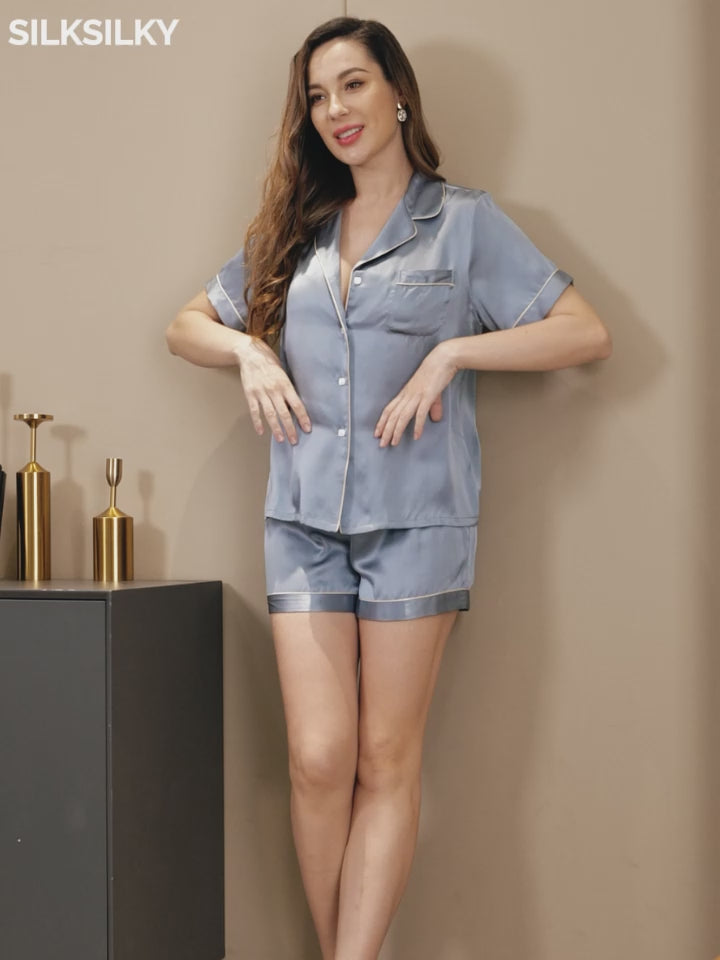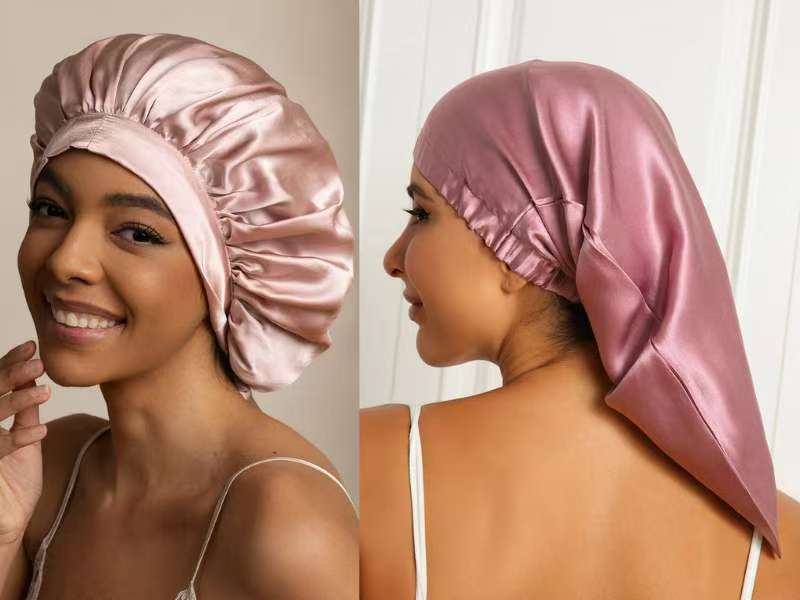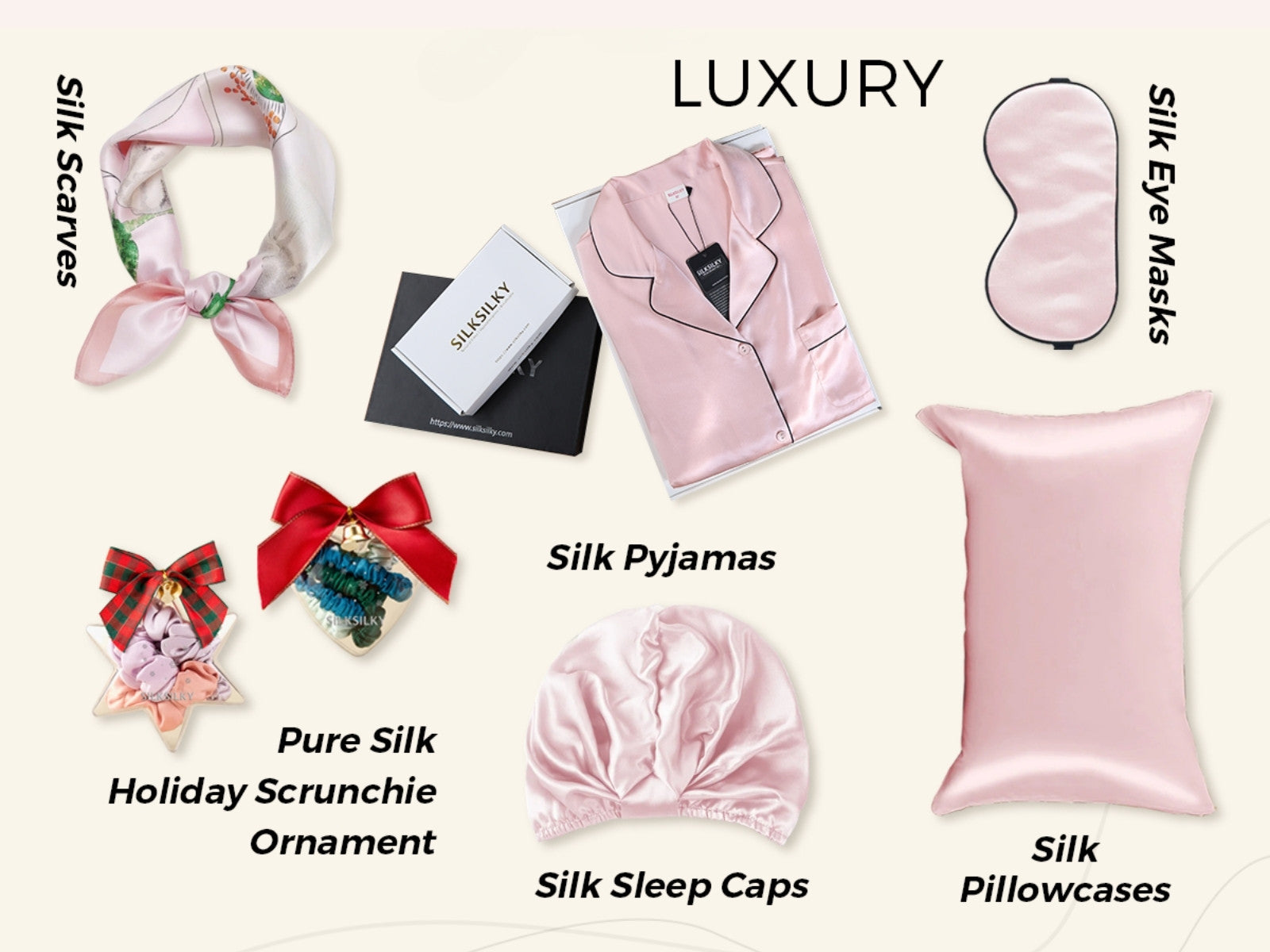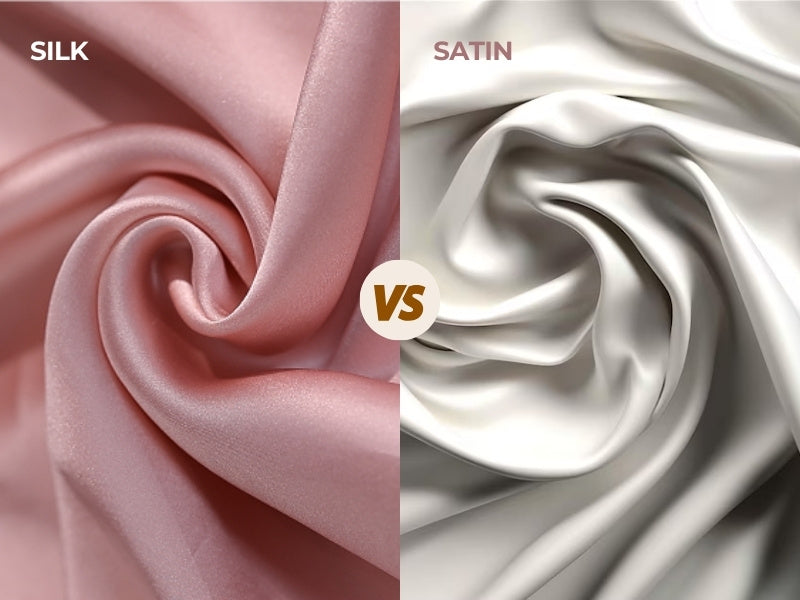What Is Mulberry Silk? Complete Guide to Real Silk, Mite Resistance & Washing Tips
Table of Contents
- What Is Mulberry Silk?
- How Is Mulberry Silk Made: From Silkworm to Luxury Fabric
- Is Mulberry Silk Real Silk? Authenticity Guide
- Why Is Mulberry Silk Worth the Investment?
- How to Wash Mulberry Silk: Complete Care Guide
- Mulberry Silk vs Other Silk Types: Comparison Guide
- How to Choose Quality Mulberry Silk: Smart Buying Guide
- Mulberry Silk Questions: Your Complete Care and Buying Guide
- Let Mulberry Silk Speak for Itself
What Is Mulberry Silk?
Mulberry silk is a type of natural silk made by Bombyx mori silkworms that are fed only white mulberry leaves. It's known for being the smoothest, strongest, and most consistent silk available. Because the silkworms are raised in controlled conditions, they spin long, unbroken threads. That's what gives mulberry silk its soft feel, glossy shine, and high durability. It's considered the best silk in the world and is often used for premium bedding, clothing, and accessories.
How Is Mulberry Silk Made: From Silkworm to Luxury Fabric
Mulberry silk doesn't just happen—it's the result of a careful, step-by-step process that starts with tiny caterpillars and ends with one of the softest, strongest fabrics in the world. Here's how it all comes together.

1. It All Starts With Silkworms
Mulberry silk comes from a special silkworm called Bombyx mori. It begins when microscopic eggs hatch into caterpillars. The tiny creatures have one food source and one food source alone—mulberry leaves. They eat round the clock for about a month, growing larger each day.
When they're fully grown, each caterpillar ensconces itself in a cocoon with a single strand of silk fiber. That single strand measures more than 3,000 feet in length (up to 1,500 meters). The cocoon encloses them as they're preparing to hatch as moths—but when it comes to making silk, timing is everything.
2. Harvesting the Cocoons
To keep the silk strand intact, farmers collect the cocoons before the moths come out. If the moth breaks through, the fiber gets cut and can't be used for high-quality silk.
The cocoons are picked by hand and then dried using sun, hot air, or steam. This stops the transformation inside. After drying, the cocoons are sorted by size and quality. Only the best ones are used to make mulberry silk.
3. Getting the Silk Thread
Then the cocoons are soaked in hot water. This loosens a natural adhesive known as sericin which binds the fibers together. Once softened, the end of the silk thread is located and carefully unwound.
Typically, 5 to 8 silk strands are reeled together to create one strong raw silk strand. The yarns are washed again to eliminate excess sericin, which softens and smooths out the silk.
4. Turning Thread Into Fabric
After cleaning and drying of the silk threads, they are spun and dyed sometimes. Then, they are woven into cloth on handlooms or machines. The result is a soft, lightweight fabric with a lovely luster. It can be lightweight and airy or thick and sumptuous, depending on the weave—ideal for apparel, bedding, or accessories.
Mulberry silk stands out because each thread comes from one long, unbroken fiber. That gives it a super smooth feel, great strength, and a consistent shine. Other types of silk, like those made from broken or wild cocoons, use shorter fibers. These don't feel as soft and tend to be less durable.
Is Mulberry Silk Real Silk? Authenticity Guide
Yes, mulberry silk is 100% real silk and represents the highest quality natural silk available, produced by domesticated Bombyx mori silkworms.
- Natural Silk Confirmation: Authentic mulberry silk is a completely natural protein fiber with no synthetic additives, making it genuine silk in every sense.
- Identifying Fake Silk: The burn test reveals authenticity – real silk smells like burnt hair and leaves ash, while synthetic fabrics melt or smell like plastic. Authentic silk feels smooth and slightly cool to touch, while fake versions feel slippery or rough.
- Quality Certifications: Look for OEKO-TEX Standard 100 or GOTS certifications, which verify the silk's authenticity and safety standards.
- Common Imposters: Beware of satin, rayon blends, or fabrics labeled as "silk-like" – these synthetic alternatives lack silk's natural properties and benefits, despite similar appearance.

Why Is Mulberry Silk Worth the Investment?
Mulberry silk is more expensive than other fabrics—but it's worth it. Not only is it silky and shiny. Its healthy, long-lasting value, and day-to-day comfort can't be beaten with less costly materials. Here's why it's worth every penny.
Keeps Your Hair and Skin Healthy
Mulberry silk also possesses a smooth surface that reduces friction. That means less pulling on your hair and less tension on your skin. You'll wake up with fewer tangles, frizz, or sleep lines. Unlike cotton, which soaks up moisture, silk lets your skin and hair hold onto their natural oils.

Remains Comfortable Throughout the Year
Silk also changes the temperature of your body naturally. It keeps you cool during hot nights and will keep you warm when it's cold. The fabric is breathable, meaning air can circulate through it easily, so you won't sweat or feel suffocated. However hot or cold the season, silk bedding ensures comfortable sleep.

Lasts Much Longer Than Other Fabrics
Mulberry silk can appear delicate, but it's more resilient than it appears. It is created using long, intact fibers that are less prone to tearing or wearing away. Good-quality silk with good care also lasts 10 to 15 years—well longer than some polyester or cotton sheets that degrade or lose color after several washes.
Will Not Irritate or Cause Allergies
Silk is also not as likely to trigger allergies. Its smooth surface also makes it harder for dust mites, mold, and bacteria to settle. If you have sensitive skin, asthma, or allergies, silk makes your sleeping area cleaner and more comfortable.

Feels Amazing Every Night
Silk has been a centuries-old option for its luxurious texture—and that hasn't changed. The soft, lightweight feel and subtle shine make for sleeping that is elegant and relaxing. Each night is a little more special when you're sleeping on real mulberry silk.
How to Wash Mulberry Silk: Complete Care Guide
Proper washing techniques are essential for maintaining mulberry silk's quality and extending its lifespan, as incorrect care can damage these delicate fibers permanently.
- Wash by Hand for Best Results: Fill a basin with cool water and add silk-specific detergent. Gently swish the fabric for 3-5 minutes, then rinse thoroughly with clean water. Never wring or twist the silk.
- Use Machine Washing Carefully: Only machine wash when the care label permits. Select the delicate cycle with cold water and place silk items in mesh laundry bags for protection.
- Choose pH-Neutral Detergents: Select detergents specifically designed for silk or wool. Avoid bleach, fabric softeners, or harsh chemicals that break down silk proteins.
- Dry Away from Heat and Sun: Always air dry silk away from direct sunlight. Lay flat on clean towels or hang carefully. Never use machine dryers as heat shrinks and damages the fibers.
- Iron on Low Heat Settings: Use low heat and iron while silk is slightly damp, or place a pressing cloth over the fabric to protect the surface.
- Store in Breathable Materials: Keep clean silk in cotton bags or wrapped in tissue paper. Avoid plastic storage which traps moisture and causes mildew.
Mulberry Silk vs Other Silk Types: Comparison Guide
Not all silk feels the same against your skin, and there's a good reason why. The type of silkworm, what it eats, and how the silk is woven all make a huge difference in quality, price, and how it performs.
Mulberry Silk vs Wild Silk (Tussah)
| Features | Mulberry Silk | Wild Silk (Tussah) |
|---|---|---|
| Source | Silkworms fed only mulberry leaves in controlled farms | Silkworms living in the wild, eating whatever they find |
| Texture | Incredibly smooth, even fibers | Rougher texture |
| Appearance | Beautiful shine | Natural color streaks, "rustic" look |
| Quality | Smoothest, strongest, most expensive | Decent quality, middle price range |
| Best Uses | Pillowcases, sheets, pajamas, anything touching skin | Curtains, scarves, clothes with natural, textured look |
Mulberry silk comes from pampered silkworms that eat only mulberry leaves in controlled farms. This creates incredibly smooth, even fibers with a beautiful shine. Wild silk (called Tussah) comes from silkworms living in the wild, eating whatever they find. The result? A rougher texture with natural color streaks - think of it as the "rustic" version of silk.

Mulberry Silk vs Charmeuse - What's the Confusion?
Here's where people get mixed up: mulberry tells you what kind of silkworm made it, while charmeuse tells you how it's woven. It's like comparing "chicken" to "grilled" - they're different categories entirely. You can actually get mulberry silk woven in the charmeuse style for an extra-smooth finish.
Mulberry silk wins for luxury - it's the smoothest, strongest, and most expensive. Wild silk sits in the middle - decent quality without the premium price tag. Synthetic "silk" is the budget option, but it won't give you the natural benefits real silk provides. Go with mulberry silk for anything touching your skin - pillowcases, sheets, pajamas. The smoothness makes a real difference for hair and skin. Wild silk works great for curtains, scarves, or clothes where you want that natural, textured look.
How to Choose Quality Mulberry Silk: Smart Buying Guide
When you've discovered what to look for—such as momme weight, grade, and reliable sellers—you can buy with confidence. It's worth a bit of research, and when you finally get the correct piece, you will feel the difference each time you wear it.
- Know the Key Specs: For bedding, seek out 19–25 momme weight—that's the ideal heaviness for durability and softness. Also, seek out 6A grade, which indicates the silk fibers are long, smooth, and of high quality. The weave needs to be charmeuse for a lustrous, soft finish.
- Know Fair Pricing: An authentic mulberry silk pillowcase can cost anywhere from $30 to $80, based on the momme weight and producer. Complete sheet sets cost between $150 and $400. Anything below these figures is likely too good to be true.
- Steer Clear of Vague Product Descriptions: Be wary of product descriptions that only state "100% silk" without the mention of the momme, grade, or type of silk. If the seller does not provide you with clear answers, shop elsewhere.
- Seek Reputable Certifications: See whether it has OEKO-TEX Standard 100, GOTS, or third-party certification. These guarantee that the silk is natural and produced without the use of toxic chemicals.
- Read the Reviews: Don't always go by 5-star reviews. Read reviews that tell you how the silk feels once washed, how it feels against your skin, and if it's as described.
- Make Sure Returns Are Allowed: Good vendors provide a return period. As you might not know whether the silk is right for your purpose until after use or washing, a return policy provides assurance.
Mulberry Silk Questions: Your Complete Care and Buying Guide
Q1: Is mulberry silk really worth the price?
Yes. It lasts a long time, feels great on your skin, helps keep you cool or warm, and is gentler on allergies than synthetic fabrics.
Q2: How long does mulberry silk last?
If you take care of it, good mulberry silk can last 10 to 15 years or even more.
Q3: Can I wash mulberry silk pillowcases in the washing machine?
Sometimes. Check the care label first. If it says yes, use cold water, the delicate cycle, and a silk-safe detergent. Put the pillowcase in a mesh bag.
Q4: Will mulberry silk shrink?
It might if you use hot water or a dryer. To keep it the same size, always wash with cool water and air dry.
Q5: Does mulberry silk keep out dust mites?
It helps. Mulberry silk naturally resists dust mites better than cotton, but it's still important to wash it often.
Let Mulberry Silk Speak for Itself
Choosing authentic mulberry silk isn't just about comfort—it's about making a choice that lasts. From smoother sleep to better skin, the benefits add up. Start with something small, like a pillowcase, and enjoy a bit of luxury that fits into your everyday life.
![[Light Blue] SilkSilky Pure Silk Notch Collar Women's Pajamas 001,](http://silksilky.com/cdn/shop/files/ab83afb9301666ee2f174a8ae72ffda4_4e9bb488-7880-40fe-9e69-f0fd823857c5.jpg?v=1764653199&width=1200)
![[Light Blue] SilkSilky Pure Silk Notch Collar Women's Pajamas 002,](http://silksilky.com/cdn/shop/files/db8dbeee5354fe3b631b963715847ffe.jpg?v=1764653202&width=1200)
![[Dark Red] SilkSilky Pure Silk Notch Collar Women's Pajamas 001,](http://silksilky.com/cdn/shop/files/599ed0811e1a5fcfa55bdc80a0279704_2643c850-a793-4475-a52b-7fef1bbd7e36.jpg?v=1762233837&width=1200)
![[Dark Red] SilkSilky Pure Silk Notch Collar Women's Pajamas 002,](http://silksilky.com/cdn/shop/files/9e022d4dd4f99aed4af8da3f58fcfd5b_efb9bafe-3d71-4283-9b81-e339ff08f352.jpg?v=1762233837&width=1200)
![[White] SilkSilky Pure Silk V Neck Nightgown 001,](http://silksilky.com/cdn/shop/files/a8ae95260a57844b1e2e00c4fcfabdcc_b922b270-af10-4e96-9493-0d877bd663db.jpg?v=1764140639&width=1200)
![[White] SilkSilky Pure Silk V Neck Nightgown 002,](http://silksilky.com/cdn/shop/files/24ac506750f8c38c51bb5b6d0ee15287.jpg?v=1764140639&width=1200)
![[Pink] SilkSilky Pure Silk Sleep Cap 001,](http://silksilky.com/cdn/shop/files/SilkSilky_Pure_Silk_Sleep_Cap_Pink_001_C-250529006.jpg?v=1762221980&width=1200)
![[Pink] SilkSilky Pure Silk Sleep Cap 002,](http://silksilky.com/cdn/shop/files/SilkSilky_Pure_Silk_Sleep_Cap_Pink_002_C-250529006.jpg?v=1762221980&width=1200)
![[Steel Blue] SilkSilky Pure Silk Notch Collar Women's Pajamas 001,](http://silksilky.com/cdn/shop/files/05b358f92fb5d252122b00d69a2fcfc5_88211a42-88c4-4448-8cb3-5f18529bfef8.jpg?v=1762237226&width=1200)








